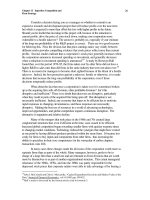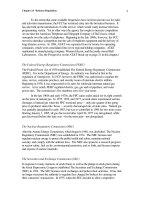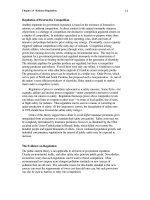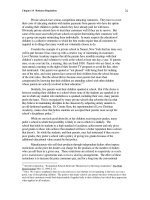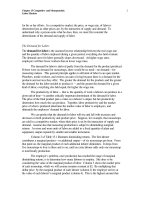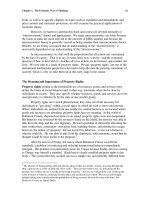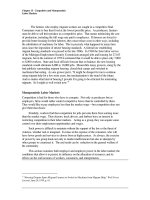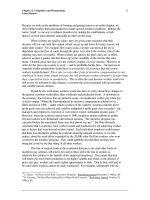Microeconomics for MBAs 53
Bạn đang xem bản rút gọn của tài liệu. Xem và tải ngay bản đầy đủ của tài liệu tại đây (44.25 KB, 10 trang )
Chapter 15 Competitive and Monopsonistic
Labor Markets
32
This is the approach for establishing salary-commission rate pay contracts at IBM.
24
It’s
not a sure-fire way of making sales people totally honest, but it can help, and that’s all
real-world managers should strive to achieve.
Incentives in Rental Contracts
Because risk sharing and risk reducing contracts can be mutually beneficial, we should
not expect two-part payment schemes to be restricted to payments by employers to
workers. They can also be a part of the payments made by tenants to landlords. Rental
agreements may not appear to involve “paying for performance,” but surely they include
performance pay. Both the landlord and tenant are intent on having an agreement that
will ensure that the other will “perform” as specified. The landlord wants the rent. The
tenant wants a nice living environment or, in the case of retail space, wants a profitable
business environment. Each wants to get as much as possible from the other.
Consider the nature of rental payments within and near the city of Irvine,
California, which is situated along the coast halfway between Los Angeles and San
Diego. Irvine is a totally planned community with 110,000 residents and 140,000 jobs
within an area of approximately 180,000 acres, or 42 square miles. It has been planned
and developed not by the usual government planning boards, but by a private wealth-
maximizing firm, the Irvine Company, which was once the Irvine Ranch.
One of the more interesting features of the city is that much of the commercial
property continues to be owned and managed by the Irvine Company, which has an
unusual contract with its commercial tenants. The contract requires that tenants make a
three-part payment: a fixed monthly rental payment; a fixed monthly payment for upkeep
of the common areas within the community shopping areas; and a payment based on a
percentage of their profits. We are told that these payments can be quite stiff. For
example, for a 1,000 square foot store in a shopping center called Fashion Island, an up-
scale mall (actually in the adjoining city of Newport Beach), the rent can be several
thousand dollars a month, plus several percentage points of the store’s profits, plus
several hundred dollars a month in maintenance fees, or so we have been told.
25
How can the Irvine Company charge so much and then take a part of the store’s
profits? It is all too tempting to conclude, as many have, that the contract is “exploitive,”
reflecting the monopoly power of the Irvine Company. Maybe so. The owners and
executives of the Irvine Company are wealthy. But, at the same time, there are good
reasons to believe that the stores also benefit from the contract, especially a provision that
gives the Irvine Company a stake in the profits of the stores in their shopping centers.
Naturally, any given store would love to retain the benefits of being in Fashion
Island (or any other of the two dozen Irvine shopping centers) and, at the same time, pay
24
This discussion of offering sales people a menu of contracts is taken from Paul Milgrom and John
Roberts, Economics, Organization and Management (Englewood cliffs, N.J.: Prentice Hall, 1992), pp. 400-
402.
25
We are not privileged to the particulars of the contracts, but the exact dollars involved are irrelevant to
our discussion.
Chapter 15 Competitive and Monopsonistic
Labor Markets
33
no rent whatsoever. On reflection, however, the storeowner could easily see that such a
deal would be a loser, unless it was virtually the only store that got such a deal. Each
storeowner can reason that the payment for the upkeep of the grounds can clearly be in
his or her best interests, given that the upkeep payments can make the whole center
attractive to customers, increasing the traffic in all stores. These mandatory payments
override the inclination of each storeowner to shirk on upkeep. The storeowners are, in
effect, employing the Irvine Company to overcome the prisoners' dilemma problem they
would otherwise face and that has been at the heart of so many other management
problems considered to this point. They want the Irvine Company to perform with the
interests of the stores in mind, as well as the interest of the Irvine company’s
stockholders. (Of course, there is a clear tie-in between the storeowners’ interests and
those of the Irvine stockholders. The better the storeowner’s do, the better the Irvine
Company does, and that’s the kind of performance tie-in that the storeowners should
seek.)
The storeowners can also reason that the high rental payments accomplish a
couple of objectives. They ensure that all stores are high-value stores, with a focused
appeal to up-scale shoppers. Low-valued stores are not likely to be able to meet the stiff
rental payments. The high payments also ensure that prices will be somewhat higher at
Fashion Island than at other shopping centers, thus causing downscale shoppers to go
elsewhere (permitting up-scale shoppers freer access to the stores). The high rental
payments also reflect the fact that the demand for the space at Fashion Island is high, and
it is high simply because the Irvine Company has done a good job of enabling the
storeowners to make high profits. Stores, in other words, don’t always want low rents,
because low rents usually go hand in hand with low profits.
But why would the stores ever want to sign a contract that enables the Irvine
Company to share in its profits? Even this provision has an advantage for the merchants,
given the conditions of the area. Storeowners understand that the Irvine Company
controls much of the commercial space in the Fashion Island/Irvine area. The Irvine
Company greatly influences the overall order of things in the area, including the income
levels of residents, the distribution of various shopping centers within the Irvine area, and
the distribution of stores within and across the shopping centers. The company has a
terrific impact on the “look” and “feel” of the community, which means the company can
greatly influence the degree of success of individual storeowners. (In many respects, the
entire Irvine area can be viewed as one big shopping mall.)
Taken together, we should not be surprised that the Irvine Company takes a share
of the stores’ profits and that the store owners (collectively) want them to do just that.
The percentage take gives the Irvine Company a direct incentive to operate in the
interests of the storeowners. If the Irvine Company allows the community to deteriorate
or allows “too many” direct (or even indirect) competitors into their shopping centers,
then the company will suffer an income and wealth loss (given that the value of their
shopping centers are a function of the stores’ profitability). Hence, we would imagine
that the standard contract is one that the storeowners like as much as the Irvine Company
does, at least in terms of its basic features. The profit percentage is a way the
storeowners can “pay for performance” on the Irvine Company’s part.
Chapter 15 Competitive and Monopsonistic
Labor Markets
34
We also should not be surprised that in many other areas of the country landlords
do not include the percentage take. This is because in so many other areas, property
ownership is often fragmented among a number of owners, with no one dominant
property owner who is capable of determining, to a significant degree, the “look” and
“feel” and profitability of individual store owners. As a consequence, storeowners are
unlikely to give a percentage of their profits to their landlord when in fact the landlord
can do little to earn the take. The landlord is unlikely to demand a percentage take
because then the landlord would have to accept a lower fixed rental payment and would
be at the mercy of the storeowner, who has complete control over the store’s profitability.
There are simply no mutual gains to be divided.
Put another, perhaps a more instructive, way, we should expect percentage takes
to be a part of lease contracts where the landlords have a significant impact on store sales,
for example, in shopping malls and other planned communities. The more fragmented
the property, the less likely (or the lower) the percentage take.
We should only infrequently expect rents to be determined totally by a percentage
take. The reason is the same as the one given above for the two-part performance pay
system for workers: Both the landlords and tenants have an interest in sharing the risk.
They both have an interest in a contract that reflects, to some degree, the influence that
one party can have on the success of the other.
Spreading the Risk Costs
Business is full of risks, and it is full of risk sharing among owners, workers, suppliers,
and even customers. Here, we have stressed that pay systems can be seen as a means by
which employers and employees alike seek to share and spread the risk costs that are
endemic to business. At its heart, the sharing will be a mutually beneficial exchange,
with both parties accepting risk so long as the gains are greater than the risk costs
incurred (or else the agreement will not last long). In addition, the pay system chosen is a
means of inducing one party to act more effectively with the interest of the other party in
mind. In a two-part pay system, the straight salary component (which can reduce the risk
cost felt by the worker by more than his or her pay is cut) can encourage employers to
ensure that there is work for employees. The piece-rate or commission component can
encourage workers to work hard and smart.
How much should workers be paid in salary and commission? The answer is a
disappointing, “It depends.” The exact combination of pay components depends on such
factors as the risk aversion of workers and how much the actual production levels in
given work environments are under the control of workers and employers. The more risk
averse workers are, the greater the salary component. This is because there is more profit
to the firm by lowering its wage bill and accepting more risk of variations in worker
incomes. The more output is dependent upon the actions of the workers, the greater the
commission component. How should employers determine the combination? A good
start would be for the employers to see if workers are willing to accept a reduction in
their overall pay with more of their income from guaranteed hourly or monthly payments.
Chapter 15 Competitive and Monopsonistic
Labor Markets
35
Of course, the firm will want to ensure that the reduction in compensation is greater than
the added cost the firm calculates it will have to incur because of the reduction in
production. The firm should continue to lower its overall wage bill that way so long as
the reduction in overall pay is greater than the increase in the loss from slack output. It
should, in other words, do what economists have long recommended -- “equate at the
margins,” balance the marginal gain with the marginal pain. In so doing, the firm cannot
only achieve maximum profits, it can actually improve the welfare of its workers.
Most books in economics rarely, if ever, mention concepts like “integrity,”
“commitment,” “credibility,” or “bonding” in their discussions of how well the economy
works. We give those concepts special attention because their importance far exceeds
their notice. Managers depend on such basic notions. The competitiveness of firms
depends on them. The efficiency of the economy depends on them. Managers and firms
have failed simply because they did not give those concepts the respect they are due.
Incentives tend to matter (in the right way) when, and to the extent, that managers’
commitments matter.
MANAGER’S CORNER II: Executive “Overpayments”
Many workers at the bottom of the typical large corporate pyramid often grumble that
their companies’ executives are living off the fat of the workers’ efforts, and that the
executives could not possibly be worth their overblown annual salaries (often running
into the tens of millions). On the surface, those who grumble seem to have a point.
The CEO of Time Warner, for example, made more than $137 million during the
last five years of the 1980s, over half of which, $78 million, was received in one year
alone (and $75 million of that year’s compensation was in the form of a bonus provided
as a reward for the merger of Time, Inc. and Warner Communications he helped
orchestrate). However, a number of other CEOs made several tens of millions during the
same period that the Time Warner CEO was pocketing his fortune.
26
The astronomical
levels of executives’ reported compensation prompt many workers and stockholders to
argue that their companies would be better served if much of the executives’
compensation and perks were used to pad the pay of lower-echelon workers.
At the same time, there is a less publicized trend in executive compensation
packages -- CEOs who risk all, taking no salary, with their reward tied totally to the
prices of their companies’ stock through grants of stock options. When he was appointed
CEO of Ingram Micro, Inc., a California-based computer distributor, in 1996, Jerre Stead
took a wage of zero in spite of the fact that Ingram was reportedly ready to pay him $1.5
million in salary and bonus.
27
Stead insisted on having the right to buy up to 3.6 million
shares of Ingram (or 2.8 percent of the company) over five years. Given that the
company, at the time of Stead’s appointment, was preparing to go public, Stead could be
a wealthy man in spite of no wage. One compensation expert estimated, at the time, that
26
See Steve Kichen and Eric Hardy, “Turnover at the Top,” Forbes, May 27, 1991, pp. 214-218.
27
As reported by Judith H. Dobrzynski, “Top Post at Rock-Bottom Wage: Chief Executive Puts Stock-Only
Pay to Ultimate Test,” New York Times, October 4, 1996, p. C1.
Chapter 15 Competitive and Monopsonistic
Labor Markets
36
if Stead could triple the price of Ingram’s stock over five years, his wealth could rise by a
hefty $100 million -- nothing to sneeze at, to say the least.
28
Of course, no one should forget that compensation tied to stock prices can
translate into no gain and all losses (measured in foregone salary opportunities). When
Nelson Peltz became CEO of Triarc Companies in 1993, a conglomerate in food,
chemicals, and energy, he accepted an annual salary of $1 along with a bundle of stock
options. As of 1996, Peltz had worked for nothing, given that he has been unable to
exercise his stock options with the price of Triac stock falling by as much as 40 percent
since the start of 1994.
29
You can bet that some CEOs fiercely defend their high incomes, especially when
their pay is dependent on their firms’ performance. Former Scott Paper CEO Al Dunlap
-- renowned for revitalizing dying companies with ruthless cuts in jobs, wages, and perks
-- exudes pride for the $6.5 billion in additional wealth he made for Scott shareholders by
radically downsizing and restructuring Scott: “My $100 million [in compensation,
attributable in large measure to stock options he received and to additional stock he
bought when he took over the head of the company] was less than 2 percent of the wealth
I created for all Scott shareholders. Did I earn that? Damn right I did. I’m a superstar in
my field, much like Michael Jordan in basketball and Bruce Springsteen in rock ‘n’
roll.”
30
He adds that if there is criticism, it should be leveled against his predecessors at
Scott who were running the company into the ground. His central admonition, all too
easily forgotten, is, “You cannot overpay a good CEO and you can’t underpay a bad one.
. . If his compensation is not tied to the shareholders’ returns, then everyone’s playing a
fool’s game.”
31
The Tenuous Connection between
Executive Pay and Performance
We agree that some workers have a complaint worthy of serious reflection. Many
corporate leaders in this country are extraordinarily well paid and, we agree, some are
probably “overpaid” (in a particular sense to be defined below), but not always for the
reasons lower-level workers give. Even Dunlap acknowledges that “only a handful of
chief executives are worth the big bucks they are paid. Many are grossly overpaid and
should be fired and then replaced by CEOs whose pay is strictly performance-based.”
32
Kenneth Mason, former president of Quaker Oaks, has much the same low opinion of the
28
Ibid., p. C3.
29
Dobrzynski, “Top Post at Rock-Bottom Wage,” p. C1. However, according to compensation analyst
Graef Crystal, Peltz’s stock options had an estimated present value of $30 million or more (Ibid., p. C3).
30
Al Dunlap and Bob Andelman, Mean Business: How I Save Bad Companies and Make Good Companies
Great (New York: Times Books, 1996), p. 21.
31
Ibid., p. 177.
32
Dunlap and Andelman, Mean Business, p. 23. Dunlap doesn’t mince many words when he adds, “In
England, where I lived for three years, they have real royalty. In America, we have corporate elitists. Both
are self-inflated windbags; they don’t believe they’re accountable to anyone. They enrich themselves at the
expense of hardworking men and women who have actually invested in our companies. It’s time they were
accountable to someone” (Ibid., p. 209).
